The X Button
Dirty High
by Todd Ciolek,

Last week brought the bitter news of EGM's fall, so I've decided to start this column by discussing something untroubling and purely frivolous: promotional game stuff. Once limited to t-shirts and the occasional soundtrack CD, the subculture of special-extra-bonus game merchandise has assumed massive proportions, as can be attested to by anyone who's tried collecting every Harvest Moon stuffed animal. The latest salvo in the merchandise campaign was fired last week by NIS America, which is planning three special bundles for the February release of Prinny: Can I Really Be the Hero? on the PSP. The basic set has a bonus soundtrack, but the next step up includes a PSP pouch and a red-scarfed plush Prinny. There's also an “Ultra Dessert” set that throws in a Disgaea manga volume, possibly left over from Broccoli's closing sale last year.
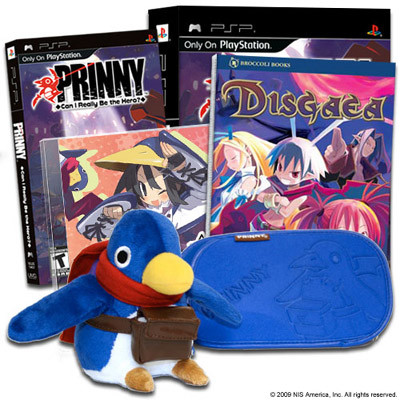
It's all well and good, but I wonder how much extra stuff fans can support. Is there a line to be drawn? Perhaps, but I like penguins too much to draw it here.
NEWS
FINAL FANTASY XIII'S WEBSITE SOUNDS FINE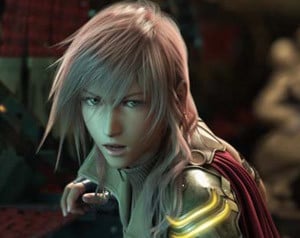 Square Enix is still vaguely promising Final Fantasy XIII to Japan by the end of this year, and they've peppered the official website with some character profiles, music, and a few new screenshots mixed in with old ones. The base anthem may sound like a standard Final Fantasy score, but let it play a few times and it'll give way to what fans have termed “the battle theme.” The characters' section gives only short and simple introductions, and Lightning still doesn't have a last name. At least there are nice, large renders of her and the other two party members we've seen so far, namely the blond, coat-wearing Snow Villiers and Oerba Dia Vanille, a perky redhead dressed mostly in beads and gauze. If the katakana is any indication, her name is indeed pronounced “Vanilla.” You can fill in the jokes from there. Square Enix is still vaguely promising Final Fantasy XIII to Japan by the end of this year, and they've peppered the official website with some character profiles, music, and a few new screenshots mixed in with old ones. The base anthem may sound like a standard Final Fantasy score, but let it play a few times and it'll give way to what fans have termed “the battle theme.” The characters' section gives only short and simple introductions, and Lightning still doesn't have a last name. At least there are nice, large renders of her and the other two party members we've seen so far, namely the blond, coat-wearing Snow Villiers and Oerba Dia Vanille, a perky redhead dressed mostly in beads and gauze. If the katakana is any indication, her name is indeed pronounced “Vanilla.” You can fill in the jokes from there.
|
ATLUS ADDS TOKYO BEAT DOWN TO 2009 SCHEDULE Sega's Yakuza series might not a blazing success in the U.S. just yet, but it's evidently forged a path for at least one other Japanese import that covers the criminal underbelly of Tokyo. Atlus recently announced a March 10th release date for the North American version of Tokyo Beat Down, which arrived in Japan last September as Yajuu Keiji: Tokyo Douji Tahatsu Tero o Chinatsu Seyo. While Yakuza is a sprawling exploration of mobster lifestyles, Tokyo Beat Down seems a more focused beat-'em-up from the days of Double Dragon, with a white-suited lead detective and his fellow cops plunging into Tokyo's many districts and pounding criminals. Sega's Yakuza series might not a blazing success in the U.S. just yet, but it's evidently forged a path for at least one other Japanese import that covers the criminal underbelly of Tokyo. Atlus recently announced a March 10th release date for the North American version of Tokyo Beat Down, which arrived in Japan last September as Yajuu Keiji: Tokyo Douji Tahatsu Tero o Chinatsu Seyo. While Yakuza is a sprawling exploration of mobster lifestyles, Tokyo Beat Down seems a more focused beat-'em-up from the days of Double Dragon, with a white-suited lead detective and his fellow cops plunging into Tokyo's many districts and pounding criminals. Breaking with the reality of Japan's gun control laws, Tokyo Beat Down also features a lot of pistols, shotguns, and submachine guns for the officers to pick up when not using bare fists and roundhouse kicks. There's also a branching story with multiple endings, all of them backed by deliberately corny dialogue and artwork seemingly inspired by the Ryoichi Ikegami school of hard-boiled urban bloodshed. The game's a joint venture between two interesting lower-level Japanese developers: once known for the Cotton shooters, Success has made a comeback in recent years with the Izuna series, while Tamsoft cranks out all sorts of budget-price games for D3, including those OneChanbara games where bikini-clad women slice through zombies. Perhaps Tokyo Beat Down will prove just as striking.
|
KLONOA NOT REDESIGNED AFTER ALL
Most of us assumed that Namco's upcoming Klonoa: The Door to Phantomile remake would come out for the Wii in North America. We just weren't sure if the lead character would look like the Klonoa we remembered from the PlayStation, the PS2, and the Game Boy Advance (and, if you were a big enough fan, the import-only Wonderswan). See, Namco put forth surveys asking if they should redesign Klonoa from this...

...into this...
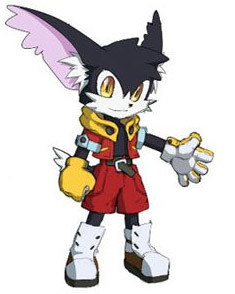
Fortunately, no one liked fox-bat Klonoa, and the Wii game, simply titled Klonoa, will have the traditional, floppy-eared version of the gibberish-spouting cat hero. The game will also remain a two-dimensional platform-jumper, albeit with some impressive new 3-D visuals.
GUILTY GEAR'S FUTURE UNCERTAIN
Finally, I would be derelict in my duties as a Guilty Gear nerd (one who even owns Dust Strikers) if I didn't mention an illuminating interview that Gamasutra conducted with the franchise's stewards at Arc System Works. It's actually quite depressing, as the responses imply that Guilty Gear is now trapped in some legal snares between Sega and Arc System Works, and that creator Daisuke Ishiwatari and his staff are turning to BlazBlue instead of making more Guilty Gear games. While this may mean fewer terrible Guilty Gear spin-offs, I would really miss the series, and BlazBlue just isn't the same.
SPECIAL FEATURE: GUNDAM GAMES
Times change, fads die, and fan bases dry up, but the anime industry will always have Gundam in some way. So too will the Japanese game market always have Gundam games of varying quality and genre. We start the new year with another round of Gundam titles on the horizon; some are interesting, some are predictable, and some just might make it to these shores.
DYNASTY WARRIORS GUNDAM 2
(PS2, PS3, Xbox 360)
 It may have the laziest possible title, but Bandai and Koei's mash-up of Dynasty Warriors and Gundam proved a predictable success in Japan, having combined two things that the nation's gaming market invariably buys. While the first game took players through a story-mode version of the original Mobile Suit Gundam and Zeta Gundam, the sequel extends through Char's Counterattack, with all of the signature mobile suits that Yutaka Izubuchi designed for the film. There's a handful of new mecha from other Gundam series, including two from Victory Gundam and the Strike Freedom, Infinite Justice, and Destiny Gundams from SEED Destiny. The gameplay still involves much slashing through slow-witted Zakus, but the sequel adds giant enemy bosses for the littler robots to scamper around and fecklessly stab.
It may have the laziest possible title, but Bandai and Koei's mash-up of Dynasty Warriors and Gundam proved a predictable success in Japan, having combined two things that the nation's gaming market invariably buys. While the first game took players through a story-mode version of the original Mobile Suit Gundam and Zeta Gundam, the sequel extends through Char's Counterattack, with all of the signature mobile suits that Yutaka Izubuchi designed for the film. There's a handful of new mecha from other Gundam series, including two from Victory Gundam and the Strike Freedom, Infinite Justice, and Destiny Gundams from SEED Destiny. The gameplay still involves much slashing through slow-witted Zakus, but the sequel adds giant enemy bosses for the littler robots to scamper around and fecklessly stab.
Key Feature: Taking on a Big Zam, which one can't help but feel sorry for when it's downed by a small Gundam in the official trailer. After all, it doesn't even have arms.
Is It Coming Here? Unlike the rest of the games in this list, Dynasty Warriors Gundam 2 actually has an American street date: March 24.
GIHREN NO YABOU: AXIS NO KYOUI V
(PS2, PSP)
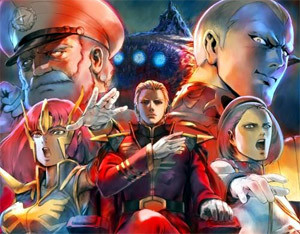 Behold further proof that the villains of Mobile Suit Gundam are more interesting and popular than the heroes. Amuro Ray and Kamille Bidan rarely get video games titled in their honor, but the would-be Zeon conqueror Gihren Zabi and his brief, Hitler-ish rise to power inspired one of the most enduring sub-series in Gundam games. Alternately translated as Gihren's Greed and Gihren's Ambition, this line of strategy-RPGs started on the Sega Saturn in 1998 and went on to span the Dreamcast, PlayStation, PSP, PlayStation 2, and even that Wonderswan Color handheld that no one remembers. The latest of them is Axis no Kyoui V, streeting for the Japanese PS2 and PSP this February 12. The typical Gihren's Ambition game plays out with yammering character cutouts and side-view robot attacks similar to Super Robot Wars, though the mecha of Gihren's Ambition are still CG-rendered puppets that look scarcely better than they did in the days of the Saturn. However, Axis no Kyoui V promises a fair share of new content, with 14 new scenarios, 550 different suits, and 260 characters. Previews for the game also point to two new difficulty levels: “Special” and “Hell.”
Behold further proof that the villains of Mobile Suit Gundam are more interesting and popular than the heroes. Amuro Ray and Kamille Bidan rarely get video games titled in their honor, but the would-be Zeon conqueror Gihren Zabi and his brief, Hitler-ish rise to power inspired one of the most enduring sub-series in Gundam games. Alternately translated as Gihren's Greed and Gihren's Ambition, this line of strategy-RPGs started on the Sega Saturn in 1998 and went on to span the Dreamcast, PlayStation, PSP, PlayStation 2, and even that Wonderswan Color handheld that no one remembers. The latest of them is Axis no Kyoui V, streeting for the Japanese PS2 and PSP this February 12. The typical Gihren's Ambition game plays out with yammering character cutouts and side-view robot attacks similar to Super Robot Wars, though the mecha of Gihren's Ambition are still CG-rendered puppets that look scarcely better than they did in the days of the Saturn. However, Axis no Kyoui V promises a fair share of new content, with 14 new scenarios, 550 different suits, and 260 characters. Previews for the game also point to two new difficulty levels: “Special” and “Hell.”
Key Feature: Nothing gets the scope of Gundam across like a world map dominated by Zeon colors.
Is It Coming Here? Unlikely. There's too much text for a simple translation and too little action for the kids who just want to wreck Zakus.
GUNDAM VS. GUNDAM NEXT
(Arcade, possibly on PSP later)
 Compared to the typical Gundam game, Gundam vs. Gundam was rather well-received in arcades and on the PSP. Such a reception may stem from it being a stable 3-D Gundam combat simulator, or maybe fans like it just because the game lets you drop space colonies as special attacks. It's also crammed with robots from nearly every Gundam series, with the lineup dominated by leading blue-and-white mecha from the RX-78 to the Gundam Exia. It then falls to the arcade sequel, Gundam vs. Gundam Next, to add less orthodox mobile suits, including G Gundam's Gundam Spiegel and Nobel Gundam, Gundam Wing's Tallgeese and Deathscythe Hell, Turn A Gundam's Turn X, Victory Gundam's Gedlav-Einerad combination, and, of course, the lovable Acguy from the original Gundam. Next also features pop-star/weirdo Gackt's cover of “Ai Senshi” as its title song.
Compared to the typical Gundam game, Gundam vs. Gundam was rather well-received in arcades and on the PSP. Such a reception may stem from it being a stable 3-D Gundam combat simulator, or maybe fans like it just because the game lets you drop space colonies as special attacks. It's also crammed with robots from nearly every Gundam series, with the lineup dominated by leading blue-and-white mecha from the RX-78 to the Gundam Exia. It then falls to the arcade sequel, Gundam vs. Gundam Next, to add less orthodox mobile suits, including G Gundam's Gundam Spiegel and Nobel Gundam, Gundam Wing's Tallgeese and Deathscythe Hell, Turn A Gundam's Turn X, Victory Gundam's Gedlav-Einerad combination, and, of course, the lovable Acguy from the original Gundam. Next also features pop-star/weirdo Gackt's cover of “Ai Senshi” as its title song.
Key Feature: Tearing across battlefields with the wheel-based Gedlav-Einerad.
Is It Coming Here? In the arcade, never. On the PSP it's entirely possible, but Bandai's said nothing about a domestic Gundam vs. Gundam yet.
MOBILE SUIT GUNDAM: SENJOU NO KIZUNA
(Arcade, PSP)
 If bringing Gundam vs. Gundam from arcades to the PSP seemed a strange move, it's nothing compared to Bandai's plan for turning Mobile Suit Gundam: Senjou no Kizuna into a PSP game. In arcades, Senjou no Kizuna is played inside a Panoramic Optical Display, a large, enclosed cabinet that mimics the cockpit of a mobile suit. Up to eight of these P.O.D.s can be linked for players to talk to each other while forming battlefield quartets and taking on other four-pilot squads. It's perhaps the closest arcade games have come to anime-accurate Gundam battles, and it's hard to imagine the game being the same on a PSP screen. The PSP version will at least preserve the four-on-four multiplayer approach with wireless play, though there seems to be no handheld substitute for covertly discussing plans over your cockpit's mic.
If bringing Gundam vs. Gundam from arcades to the PSP seemed a strange move, it's nothing compared to Bandai's plan for turning Mobile Suit Gundam: Senjou no Kizuna into a PSP game. In arcades, Senjou no Kizuna is played inside a Panoramic Optical Display, a large, enclosed cabinet that mimics the cockpit of a mobile suit. Up to eight of these P.O.D.s can be linked for players to talk to each other while forming battlefield quartets and taking on other four-pilot squads. It's perhaps the closest arcade games have come to anime-accurate Gundam battles, and it's hard to imagine the game being the same on a PSP screen. The PSP version will at least preserve the four-on-four multiplayer approach with wireless play, though there seems to be no handheld substitute for covertly discussing plans over your cockpit's mic.
Key Feature: In the arcade version of Senjou no Kizuna, you can recreate the tone of a Gundam anime by whining to your fellow pilots about how you don't want to fight because war is bad. For an extra touch of Gundam verisimilitude, have your teammates get out of their cockpit cabinets and slap you.
Is It Coming Here? No sign of one yet, but Senjou no Kizuna has an English website that encourages you to “FEEL YOUR PARTNERS.”
RELEASES FOR THE WEEK OF 1-18
AR TONELICO 2: MELODY OF METAFALICA |
|
STAR OCEAN: SECOND EVOLUTION (Square Enix, PSP, $39.99)  I have to give Square Enix credit for delivering both Star Ocean PSP remakes in quick succession, as Star Ocean: First Departure came out a mere three months ago. Yet Second Evolution isn't as extensive of a revamp as its predecessor. While First Departure overhauled the original Star Ocean's visual style and battle system, Second Evolution sticks closer to the game PlayStation owners knew as Star Ocean: The Second Story. The story stays mostly the same: space cadet Claude Kenni gets warped to a primitive planet, rescues a elfish native girl named Rena, and gets thrown into an adventure involving planetary destruction and three-eyed women warriors. The battles are made somewhat easier by a new combo system, and the original game's elaborate skill system and optional character skits (or “private actions,” as the game suggestively dubs them) are intact. The graphics are essentially the original PlayStation game's backdrops stretched out on a PSP screen, but with new character art and a few animated sequences. Square's also likely to re-record all of the voice acting for the PSP version, which should please anyone who sat through the original game's agonizingly memorable performances. I have to give Square Enix credit for delivering both Star Ocean PSP remakes in quick succession, as Star Ocean: First Departure came out a mere three months ago. Yet Second Evolution isn't as extensive of a revamp as its predecessor. While First Departure overhauled the original Star Ocean's visual style and battle system, Second Evolution sticks closer to the game PlayStation owners knew as Star Ocean: The Second Story. The story stays mostly the same: space cadet Claude Kenni gets warped to a primitive planet, rescues a elfish native girl named Rena, and gets thrown into an adventure involving planetary destruction and three-eyed women warriors. The battles are made somewhat easier by a new combo system, and the original game's elaborate skill system and optional character skits (or “private actions,” as the game suggestively dubs them) are intact. The graphics are essentially the original PlayStation game's backdrops stretched out on a PSP screen, but with new character art and a few animated sequences. Square's also likely to re-record all of the voice acting for the PSP version, which should please anyone who sat through the original game's agonizingly memorable performances. Get Excited If: The voices scared you away from the PlayStation version of Star Ocean: The Second Story.
|
ALSO THIS WEEK
The oft-delayed Ultimate Shooting Collection, covered back in December.
EXTRA LIVES: VOLTAGE FIGHTER GOWCAIZER
 Voltage Fighter Gowcaizer is the worst anime ever extracted from a video game, and that's quite an accomplishment given the genre's low standards. Drawing from a mostly plotless fighter is rarely a good idea, but the three-part Voltage Fighter Gowcaizer series goes far beyond the realm of routinely awful fighting-game anime by tarring its nonsensical plot with intensely annoying characters, stomach-turning plot points, and the hideous artwork that only director Masami Obari can provide. In other words, it's crap. A big pile of shiny, pointy, jelly-breasted, insect-eyed crap. But what about the video game that inspired it?
Voltage Fighter Gowcaizer is the worst anime ever extracted from a video game, and that's quite an accomplishment given the genre's low standards. Drawing from a mostly plotless fighter is rarely a good idea, but the three-part Voltage Fighter Gowcaizer series goes far beyond the realm of routinely awful fighting-game anime by tarring its nonsensical plot with intensely annoying characters, stomach-turning plot points, and the hideous artwork that only director Masami Obari can provide. In other words, it's crap. A big pile of shiny, pointy, jelly-breasted, insect-eyed crap. But what about the video game that inspired it?
Now that I think about it, the “inspired” part is dubious, because the people behind Voltage Fighter Gowcaizer clearly planned an anime spin-off before the game was finished. While the Gowcaizer fighting game was released on the Neo Geo in 1995, a year before the OAV series came around, it clearly strives for flashy cartoon excess. Observe the intro, which fluidly parades its Obari-designed cast of superheroes, martial artists, robots, and monsters, culminating with a trademark Obari shot of two beefy heroes colliding fist-to-fist. Of course, the most detailed animation is saved for the bouncing chest of pop-idol policewoman Shaia Hishizaki. Her buglike, slick-skinned look sums up Obari's style aptly, but he provides plenty of other characters, including the tights-clad wrestler Captain Atlantis, the professor-turned-ninja Fudomaru, the Guyver-esque Brider, the robotic Marion, the generic-shirtless-warrior Shen Long, the winged, guitar-wielding Hellstinger, and the cloud-riding Karin Son, who serves as Obari's female version of Son Goku.
 Gowcaizer shares the anime version's stage of an earthquake-ravaged future Tokyo academy where just about every major character is a student or teacher, but there's little mention of an ongoing plot. At most, you'll see a specialized introduction when Gowcaizer himself takes on his rival Kyosuke Shigure. It'll be familiar to anyone who's endured the anime, and the combining Platonic Twins, easily the creepiest part of the Gowcaizer OAV, show up to form a second-to-last boss, with the final challenge provided by the towering school principal Ohga.
Gowcaizer shares the anime version's stage of an earthquake-ravaged future Tokyo academy where just about every major character is a student or teacher, but there's little mention of an ongoing plot. At most, you'll see a specialized introduction when Gowcaizer himself takes on his rival Kyosuke Shigure. It'll be familiar to anyone who's endured the anime, and the combining Platonic Twins, easily the creepiest part of the Gowcaizer OAV, show up to form a second-to-last boss, with the final challenge provided by the towering school principal Ohga.
Now-vanished developer Technos Japan was known primarily for creating brawlers like Double Dragon and the multi-genre Kunio-kun games (including the NES masterpiece River City Ransom), but not so much for making one-on-one fighting games. Gowcaizer was the second Neo Geo offering from Technos, following a thoroughly unremarkable Double Dragon fighter, and the designers had few ambitions. Seldom approaching the depth of even the basic Street Fighter II engine, Gowcaizer's controls resemble those of SNK's Fatal Fury series, mixing standard rolling “fireball” motions with the occasional bizarre diagonal maneuvers. Even Gowcaizer's few innovative moves, such as Kyosuke's summoned energy-animal sidekicks, seem pedestrian by the standards of any post-1995 fighter.
 For a game littered with parodies and self-conscious overkill, Gowcaizer's actual combat differs very little from the standard fighting games of its era. The game engine doesn't move particularly fast or throw out many gaudy, screen-filling attacks, an odd deficiency considering that smooth, sparkling fights are Obari's greatest (and possibly only) strength as an anime director.
For a game littered with parodies and self-conscious overkill, Gowcaizer's actual combat differs very little from the standard fighting games of its era. The game engine doesn't move particularly fast or throw out many gaudy, screen-filling attacks, an odd deficiency considering that smooth, sparkling fights are Obari's greatest (and possibly only) strength as an anime director.
Not that Gowcaizer's cast is completely bereft of personality. Captain Atlantis strikes bodybuilder poses when blocking, and one of Shaia's moves has her cringing while blind-firing a pistol into the ground. Let it never be said that fighting games are sexist. Technos put some effort into the game's backdrops as well. Brider's stage is an underground base full of Kamen Rider-style mad scientists and their creations, while Shaia gets a TV studio thronged with cheering crowds and huge screens. On the other hand, Hellstinger's level is a well-intentioned mess, full of glowing demon-rock décor and heavy-metal band members that make it hard to see the fighters in the foreground. The soundtrack is average, and the voices, furthering the “Just wait for the anime!” atmosphere, are provided by many of the same actors who later joined in the OVA.
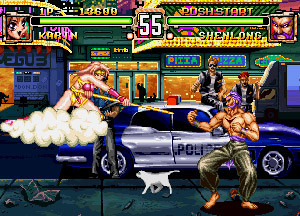 There is, however, one interesting feature in Gowcaizer: players can gain moves from defeated foes. It's a shame that most of these acquirable powers are boring. Kyosuke's is a low sweep, Marion's is a rising punch, and Gowcaizer himself bestows only an aerial kick. To weaken the idea further, the game only lets a player store one of these extra moves at a time, forcing you to dump a potentially effective attack for a useless one. The entire concept was put to better use a year before Gowcaizer by Strata's BloodStorm, a gory, tasteless rush-job of a fighter that nevertheless allowed players to build up an arsenal of opponents' special moves. It's a rare game that makes BloodStorm look good.
There is, however, one interesting feature in Gowcaizer: players can gain moves from defeated foes. It's a shame that most of these acquirable powers are boring. Kyosuke's is a low sweep, Marion's is a rising punch, and Gowcaizer himself bestows only an aerial kick. To weaken the idea further, the game only lets a player store one of these extra moves at a time, forcing you to dump a potentially effective attack for a useless one. The entire concept was put to better use a year before Gowcaizer by Strata's BloodStorm, a gory, tasteless rush-job of a fighter that nevertheless allowed players to build up an arsenal of opponents' special moves. It's a rare game that makes BloodStorm look good.
If the Voltage Fighter Gowcaizer anime made some (horrible) impressions when it arrived in America, the same can't be said for the Neo Geo game. Not only was 1995 a ridiculously busy year for video games, it also marked the point where everyone grew sick of 2-D fighters, particularly on the Neo Geo. Gowcaizer slipped through just about every fan community, with some Neo Geo lunatics noticing it just long enough to pan it thoroughly. Technos didn't give up completely, however, as a PlayStation version came out in 1997 courtesy of Urban Plant Ltd., a company that appears to have existed just to port and promote Technos Japan's fighters. A lousy conversion, the PlayStation's Gowcaizer tries to make up for stiffer animation and gameplay by adding a 3-D “diorama” feature. This useless option merely shifts the game's perspective a little bit, letting players view paper-thin 2-D characters at an angle.
As a fighter, Voltage Fighter Gowcaizer is garish and merely forgettable, which technically means that it's a better video game than the OAV series is an animated production. It's not quite the worst Neo Geo fighting game (that'd be the plastic-looking Ragnagard), but there isn't a single defensible reason to play Voltage Fighter Gowcaizer, unless you're one of the few who actually liked the awful anime it spawned. I know you're out there.
The original, cartridge-based Neo-Geo release of Voltage Fighter Gowcaizer is fairly expensive, though there's also a cheaper CD version that's sure to give you plenty of long loading pauses in between bouts of mediocre fighting. The even worse PlayStation port is harder to find, which I'd attribute more to a limited print run rather than anyone actually wanting it.
discuss this in the forum (43 posts) |
this article has been modified since it was originally posted; see change history
 I'll always remember the original Ar tonelico as the first North American game with a press release that actually mentioned “moe.” This was in 2007, well before any domestic anime or manga company would dare to officially name the art of making lonely geeks care a little too much about cartoon women. And there was plenty of moe material in Ar tonelico: Melody of Elemia, a turn-based RPG that explored the relationships a human teenage warrior built with artificial girls called Reyvateil (yes, that made them doubly manufactured characters). Set in a terraformed fantasy world, Ar tonelico 2 finds a young soldier named Croix at the heart of church's war against its own goddess. This, of course, has him encountering all sorts of women, including Croix's estranged childhood friend Luca, the overbearing Grand Bell church spokeswoman Cloche, and the lyre-playing ranger Amarie. As before, Ar tonelico 2 lets Croix “dive” into a Reyvateil's Cosmosphere and strengthen his bond with her, thus making her more willing to wear different outfits and have baldly sexual conversations about Croix inserting life-giving crystals into her. There's even an option for the game's female cast to strengthen their song-based battle techniques by taking crystal baths together.
I'll always remember the original Ar tonelico as the first North American game with a press release that actually mentioned “moe.” This was in 2007, well before any domestic anime or manga company would dare to officially name the art of making lonely geeks care a little too much about cartoon women. And there was plenty of moe material in Ar tonelico: Melody of Elemia, a turn-based RPG that explored the relationships a human teenage warrior built with artificial girls called Reyvateil (yes, that made them doubly manufactured characters). Set in a terraformed fantasy world, Ar tonelico 2 finds a young soldier named Croix at the heart of church's war against its own goddess. This, of course, has him encountering all sorts of women, including Croix's estranged childhood friend Luca, the overbearing Grand Bell church spokeswoman Cloche, and the lyre-playing ranger Amarie. As before, Ar tonelico 2 lets Croix “dive” into a Reyvateil's Cosmosphere and strengthen his bond with her, thus making her more willing to wear different outfits and have baldly sexual conversations about Croix inserting life-giving crystals into her. There's even an option for the game's female cast to strengthen their song-based battle techniques by taking crystal baths together.